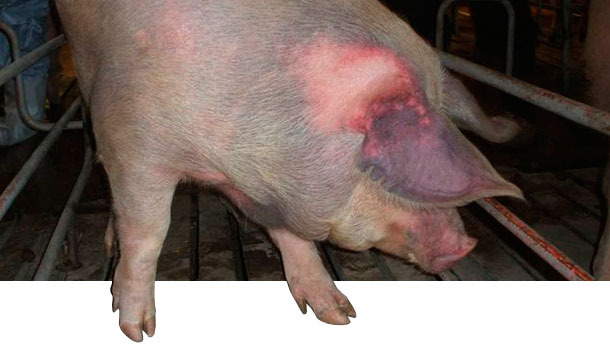Korean farmers raised 14.5 million pigs this year, what is an increase of 3.05% compared to 2013. Average size of farms in Korea is approximately 200 sows. Most pigs are raised in all-in, all-out systems, mostly in independent farms. Large integrated farms operate as two-site systems. A two-site system has breeding, gestation, and farrowing/nursery at one site, and grow/finish pigs at a separate site.
Porcine reproductive and respiratory syndrome (PRRS) is one of the most economically devastating diseases for Korean pig industry. PRRSV is classified into type 1 (European) and type 2 (North American) genotypes based on the 3′-terminal structural genes or the entire genome. Type 1 PRRSV is further divided into at least four genetic subtypes: a pan-European subtype 1, and East European subtypes 2,3 and 4 (Stadejek et al. 2013). In Korea, type 2 PRRSV was first isolated during the global epidemic in 1994 (Kweon et al. 1994) while later, type 1 PRRSV was also isolated in 2005 (Nam et al. 2009). Type 1 PRRSV isolated in Korea belonged to the pan-European subtype 1 (Kim et al. 2010). The origin of type 1 PRRSV in Korea is unknown. However, more than 10,000 gilts had been imported into Korea from European countries such as England, Denmark, and Belgium during 2003-2006, according to the National Veterinary Research and Quarantine Service. Therefore, it may be speculated that the origin of type 1 PRRSV may be the gilts imported from European countries. Since 2005, both type 1 and type 2 PRRSV are circulating in the field. Incidence of type 1 and type 2 PRRSV in Korean pig farms is 29.4% and 54.4%, respectively (Lee et al. 2010). Co-infection with both strains is also common (16.2%) (Lee et al. 2010).


Fig 1. Naïve gilts were naturally infected with type 1 PRRSV and showed cyanosis (“blue ear disease”) in ear.
Clinical presentation
The severity and duration of respiratory disease caused by type 1 PRRSV infection is highly variable under field conditions. Some Korean pig farms where type 1 PRRSV circulates experience severe respiratory disease, others, endemic respiratory diseases, but in many herds, no clinical disease is observed. It has become apparent that there are differences in the virulence and the severity of the respiratory disease for the different type 1 strains from Korea, under experimental conditions (Han et al. 2010a).
Type 1 and type 2 PRRSV exhibit different levels of virulence with respect to their ability to cause respiratory diseases in growing pigs. Type 2 strains generally induce more severe respiratory diseases in growing pigs than type 1 strains in Korea (Han et al. 2010b). In contrast to respiratory disease, significant virulence differences are not observed between type 1 and type 2 in terms of reproductive failure in breeding females (Han et al. 2014). Type 1 strains can cause abortions and near-term delivery of stillborn fetuses in pregnant gilts, like type 2 strains (Han et al. 2013a). Similarly, type 1 and type 2 PRRSV do not differ in virulence for male reproductive system of boars (Han et al. 2013b).
Diagnostic issues
For the diagnostic aspect, PCR is the only practical method to detect and differentiate type 1 PRRSV from type 2 PRRSV in diagnostic cases because commercial ELISA assay cannot differentiate antibodies against type 1 PRRSV from antibodies against type 2 PRRSV.
Therefore, many diagnostic laboratories use PCR for the detection and differentiation between type 1 and type 2 PRRSV in diagnostic cases.
Disease control
Currently, PRRSV control, rather than elimination, may be a more efficient and realistic strategy due to the common use of continuous production systems with high pig density and high PRRSV prevalence in Korea. Although several options for PRRSV control are available, a strategic combination of vaccination and pig flow management would be beneficial for PRRSV control. Only type 2 PRRSV-based modified live vaccine has been used to control PRRS until 2014. Since then, two commercial type 1 PRRSV-based modified live vaccines were licensed in Korea for the control of type 1 PRRSV infection. Once type 1 PRRSV-based modified live vaccines were introduced into Korean market, farms infected with type 1 strains are vaccinated with type 1 PRRSV-based modified live vaccine. Korean farmers usually apply a mass vaccination program, in which all pregnant and non-pregnant sows, and gilts are immunized every 4 months.

Conclusions
In conclusion, type 1 PRRSV is highly prevalent in Korean swine herds. At the present time, consequences of infection by type 1 PRRSV due to reproductive failure in breeding females are more important than respiratory disease is in growing pigs. Type 1 PRRSV-based modified live vaccine is efficacious to control pigs against type 1 PRRSV.






